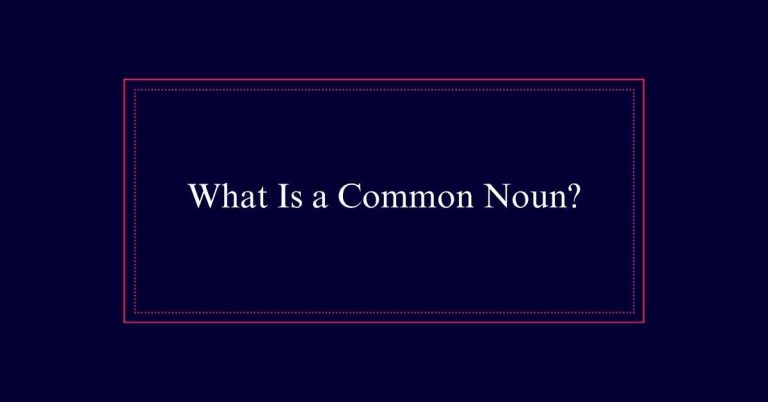When to Use a Colon?
Use a colon to link related concepts, introduce lists, or emphasize details. A colon connects two related independent clauses: “She had one goal: to win.” It efficiently introduces lists: “Bring the following items: pencils, notebooks, and textbooks.” Use it before quotes after a complete sentence: “He often said: ‘Knowledge is power.’”
What Is a Colon?
A colon is a punctuation mark that serves to connect closely related elements within a sentence. It is often used to link two independent clauses. These clauses should be related to each other. A colon is softer than a period but more definitive than a semicolon.
Colons are also used for various purposes. They can introduce lists, quotes, or examples. In addition, they can be used to provide further clarification or explanation. The element following the colon must always relate closely to the preceding part.
In English, capitalization after a colon varies. In British English, capitalize if it’s a proper noun or acronym. In American English, capitalize if it starts a complete sentence or is a proper noun.
Using Colons for Emphasis
Colons can be powerful tools for emphasizing key information within a sentence. When you want to draw attention to a specific detail, a colon can effectively highlight it.
For instance, in the sentence ‘She had one goal: excellence,’ the colon emphasizes the word ‘excellence,’ making it stand out. This use of colons helps to underscore the importance of the information that follows.
Another example is in directives or instructions. Consider this sentence: ‘Remember to bring the essentials: passport, tickets, and wallet.’ Here, the colon signals that what follows is essential.
Colons for Independent Clauses
In writing, a colon can effectively link two closely related independent clauses. This usage helps to highlight the second clause, providing emphasis or further explanation. Unlike a period, which separates thoughts, a colon shows a direct connection between the clauses. For example, “She had one goal: to win the race.”

Here is a table to illustrate the use:
| Example Sentence | First Clause | Second Clause |
|---|---|---|
| “He was clear about one thing: success.” | “He was clear about one thing” | “success” |
| “There is only one rule: be on time.” | “There is only one rule” | “be on time” |
| “Remember this: practice makes perfect.” | “Remember this” | “practice makes perfect” |
| “She made a promise: never give up.” | “She made a promise” | “never give up” |
Introducing Lists With Colons
While colons can link independent clauses, they are also highly effective in introducing lists. When a list follows a complete sentence, a colon is the ideal punctuation to signal what comes next.
For example, consider this sentence: ‘For the picnic, we need to bring several items: sandwiches, drinks, fruit, and napkins.’ The colon tells the reader a list is coming.
Ensure the clause before the colon is a complete sentence. Incorrect usage would be: ‘For the picnic, we need: sandwiches, drinks, fruit, and napkins.’ This is because the clause before the colon is not a complete sentence.
Colons Before Quotes
Introducing quotes effectively often requires the strategic use of a colon. When introducing a quote, a colon can provide a clear and strong connection between your introductory statement and the quote itself.
For instance, use a colon after a complete sentence that leads into the quote:
The author emphasizes the importance of perseverance: ‘Success is not final, failure is not fatal: it is the courage to continue that counts.’
Notice that the sentence before the colon is complete and sets up the quote. This method guarantees a smooth shift and highlights the quote’s significance.
Clarifications With Colons
For clarifying or elaborating on a preceding statement, a colon can be your best tool. It introduces additional information that explains or defines the earlier part of the sentence. For example, consider the sentence, ‘She had one goal: to win the championship.’ Here, the colon clarifies what the goal is.
Colons are also useful when you want to emphasize a point. For instance, ‘He had only one option left: quit his job.’ The colon highlights the critical nature of the decision.
Another example could be, ‘The recipe requires just three ingredients: flour, sugar, and eggs.’ In this case, the colon is used to specify the components needed.
Colons Vs. Semicolons
Understanding the differences between colons and semicolons is essential for clear and effective writing. While both punctuation marks connect related ideas, their uses vary. Colons introduce lists, quotes, or explanations. Semicolons link closely related independent clauses or separate items in complex lists.
Here’s a quick comparison:
| Usage | Colon Example | Semicolon Example |
|---|---|---|
| Lists | She bought: apples, oranges, bananas. | She bought apples; she also bought oranges. |
| Quotes | He said: “Welcome home.” | N/A |
| Explanations | The reason is simple: he forgot. | I have a meeting; it starts at noon. |
| Clauses | N/A | The sky is clear; the stars are visible. |
Capitalization After Colons
Capitalization after colons varies between British and American English conventions.
In American English, when the clause following the colon is a complete sentence, it is often capitalized. For example: ‘She had one goal: To become a doctor.’
However, if the text after the colon is not a complete sentence, it remains lowercase: ‘She bought three items: apples, oranges, and bananas.’
In British English, the rules are slightly different. Generally, only proper nouns or acronyms are capitalized after a colon. For instance: ‘He visited three cities: London, Paris, and Rome.’
Common Colon Usage
Colons serve various functions in writing, from introducing lists to providing further explanation. They are commonly used to signal the reader that what follows will expand on what came before.
One typical use is to introduce a list. For instance, after a complete sentence, a colon can lead into a series of items.
Another common usage is to introduce a quotation, especially when the quote illustrates or explains the preceding statement.
Colons are also used to separate independent clauses when the second clause elaborates on the first. Additionally, they can be employed to emphasize a particular point or clarification.
What Are the Correct Uses of a Colon in Writing?
When it comes to punctuation, knowing the correct uses of semicolons versus colons dashes can greatly improve your writing. Semicolons are typically used to separate closely related independent clauses, while colons are often used to introduce a list or an explanation. Dashes, on the other hand, can indicate a sudden change in thought.
Examples of Colons
Several examples can illustrate how colons are effectively used in writing.
A common use is to introduce a list:
‘The grocery list includes: apples, bread, milk, and eggs.’
Colons can also precede quotations, such as in this sentence:
‘She reminded us of an old saying: ‘Actions speak louder than words.”
Another use is to provide clarification or explanation:
‘He had one goal in mind: success.’
Colons also appear in titles with subtitles:
‘The Art of Writing: An In-depth Guide.’
Finally, colons can separate related independent clauses where the second clause explains the first:
She was ecstatic: her hard work had finally paid off.







